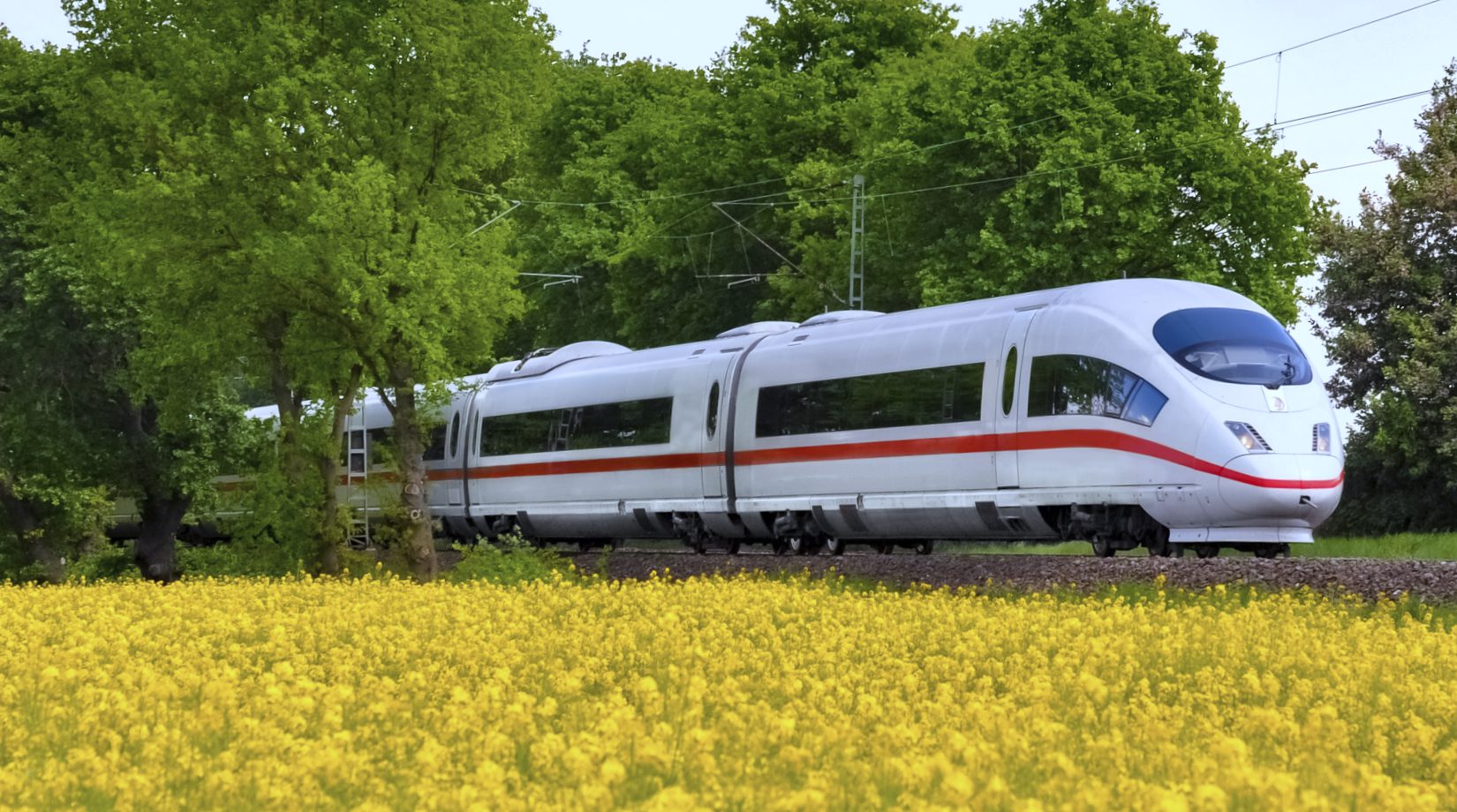
89% of rail professionals believe that on-train Internet connectivity will be ‘Important’ or ‘Very Important’ to the overall future and development of the rail industry. This was one of the key findings of Icomera’s 2024 On-Train Internet Connectivity Survey.
In H1 2024, we spoke to 343 rail industry professionals working across a wide range of roles in Europe and North America, seeking their input on the various aspects of onboard Internet connectivity for trains.
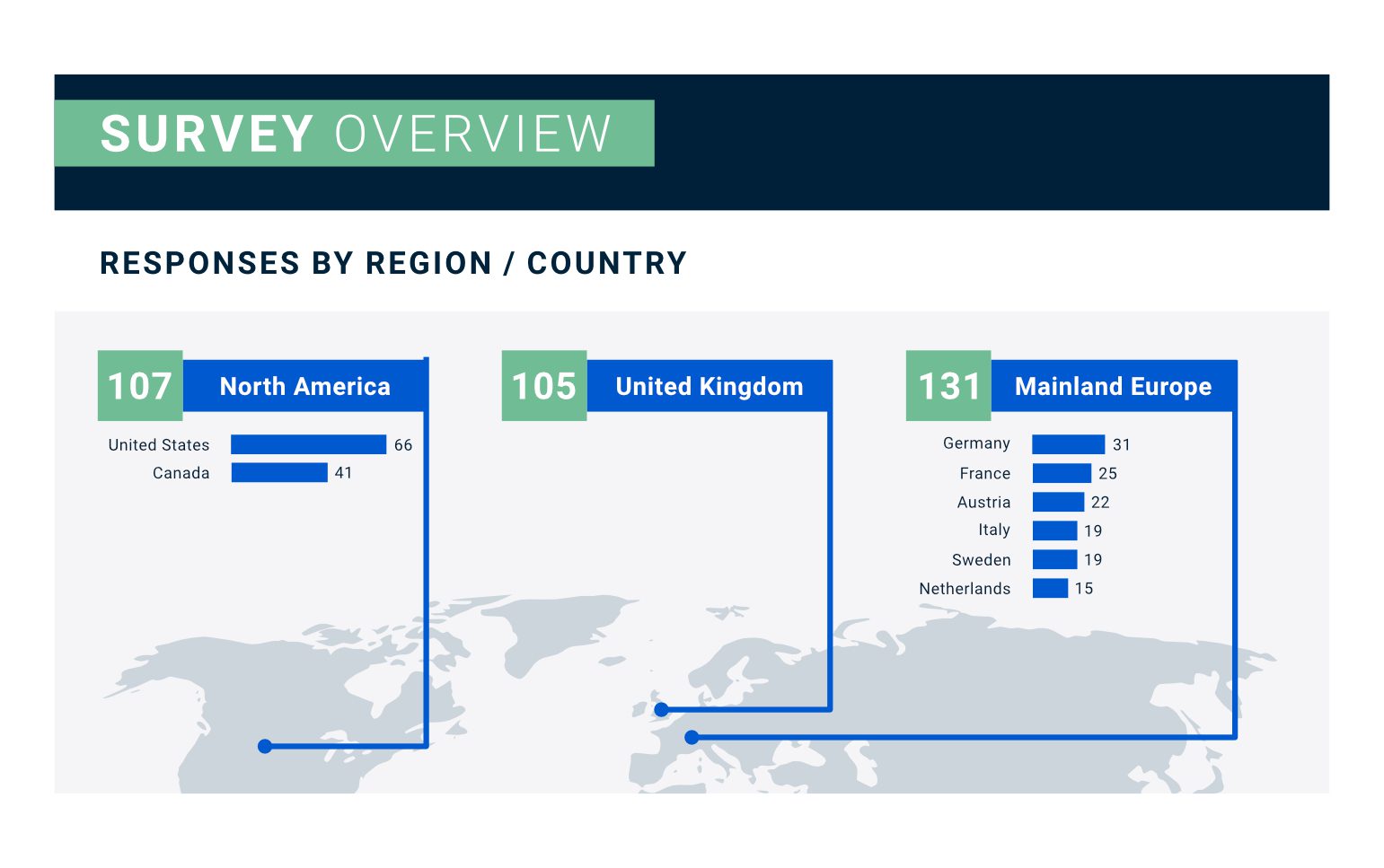
The survey collected a broad range of views on the quality, challenges, and potential improvements related to all onboard Internet-connected systems and services, ranging from passenger Wi-Fi to other, more operational- or security-focused applications like remote vehicle condition monitoring or video surveillance.
Other key takeaways from the survey include:
1. On-train Internet connectivity’s role in the future of the rail industry will be multifaceted.
2. 72% of rail industry professionals are ‘satisfied’ or ‘very satisfied’ with the current Internet Connectivity provided on trains for passenger and operational applications.
3. A combination of established and emerging communication technologies will significantly enhance Internet connectivity on trains.
4. Given its importance, 87% of rail industry professionals believe there should be more investment in improving onboard Internet connectivity.
This year Icomera is celebrating its 25th anniversary and the survey answers we received may have looked very different in 1999, when the concept of Internet on-the-go was in its infancy. The term ‘Wi-Fi’ had just been coined, the first 3G roll-out wouldn’t arrive until 2002, and even 4G networks were ten years away.
But in Gothenburg, Sweden, four pioneering students were developing “multicellular aggregating technology”, creating the fastest, most reliable Internet connection possible for a moving vehicle and, in the process, Icomera was born.
Icomera deployed the rail-industry’s first commercial onboard passenger Wi-Fi service with Swedish rail operator SJ in 2003. In the years since, onboard connectivity has evolved from a luxury consideration to an essential service and Icomera has become a global company, providing wireless connectivity to the vehicles of many of the world’s leading transport operators, connecting millions of Wi-Fi users and tens of thousands of trainsets, trams, buses and coaches around the globe every day.
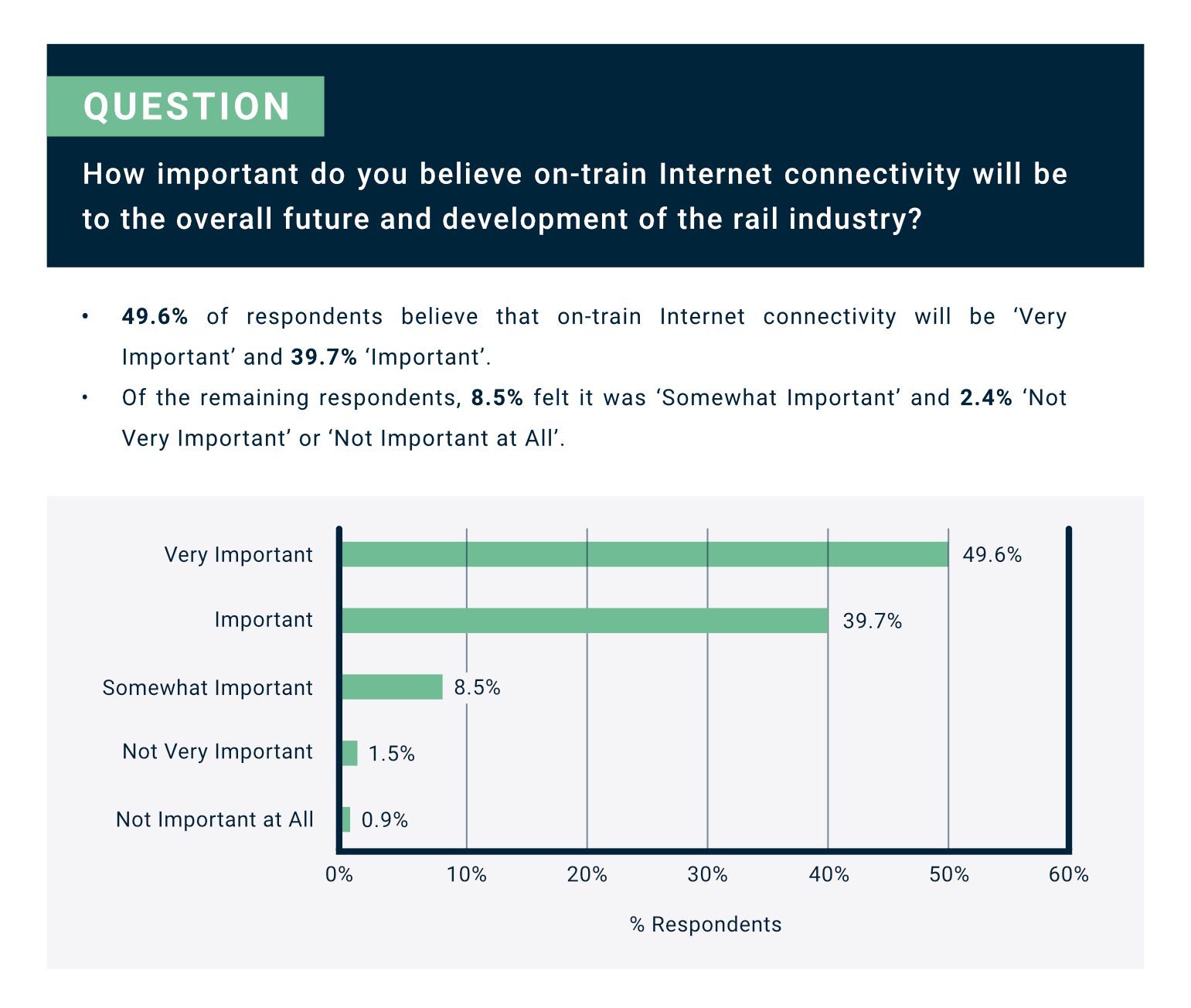
1. On-Train Internet Connectivity’s Role in the Future of Rail Will Be Multifaceted
While passenger Wi-Fi has historically been the most obvious application for ‘Internet on board’, and understandably receives a greater share of attention from the general public, those working across the rail industry take a broader view.
When asked to give their opinion on what roles on-train Internet connectivity could play in the future of the rail industry, the benefits for the Passenger Experience were most frequently recognised (by 64% of respondents), followed by Operational Efficiency (60%), and Safety and Security (40%).
The only regional deviation from this order was in mainland Europe, where Passenger Experience and Operational Efficiency opportunities were both recognised by 53% of respondents. 65% of North American professionals specifically highlighted the potential impact of connectivity on operational efficiency, more than any other region. Respondents from the UK were more inclined to emphasise the importance of connectivity for safety and security (47% of UK respondents).
At Icomera, we see a growing proportion of the Internet connectivity we are delivering to trains being used by Internet-of-Things (IoT) applications for remote monitoring and data analytics, improving the safety and operational efficiency of rail operations.
Combined with the passenger services we support, we are ensuring confidence from origin to destination, making every journey more time-efficient for passengers, and more cost-effective for rail operators.
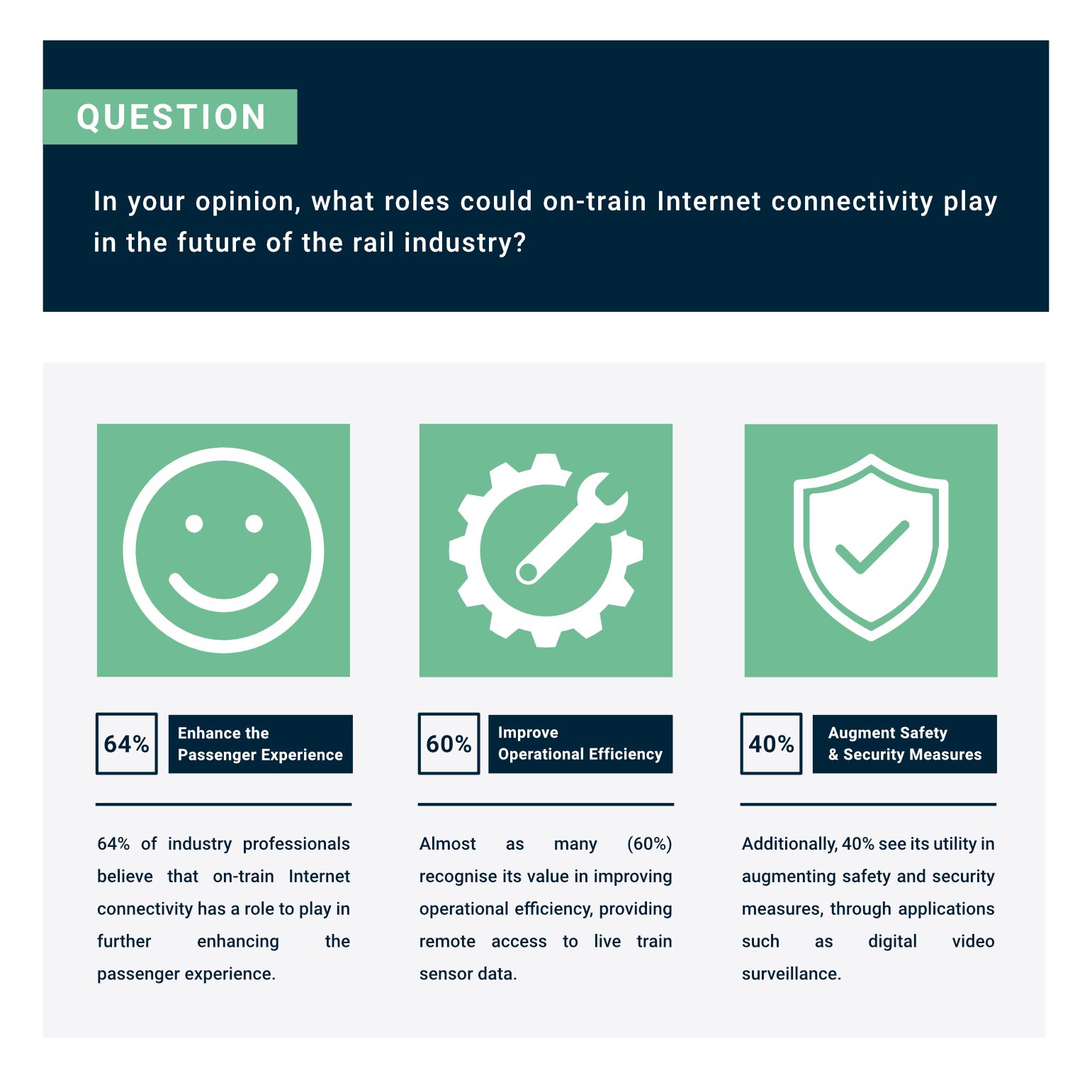
2. Rail Industry Professionals Are ‘Satisfied’ or ‘Very Satisfied’ With the Current Internet Connectivity Provided on Trains for Passenger and Operational Applications
Our survey reveals that the rail industry is, on the whole, satisfied with the current state of on-train Internet connectivity. This does contrast with other surveys that focus purely on passengers’ perceptions of onboard Wi-Fi services. For example, a recent survey by Uswitch found that only 55% of users reported ‘Good’ or ‘Excellent’ experiences on even the best on-train Wi-Fi services.
This discrepancy between the views of rail industry professionals and their passengers may be due to a combination of factors:
• Firstly, the industry professionals were asked to take operational applications into account when assessing the current state of on-train Internet connectivity. These often require less bandwidth than passenger Wi-Fi services and so more often perform in-line with expectations.
• Secondly, there is greater general awareness amongst rail industry professionals of the challenges involved in providing connectivity to and from a moving vehicle compared to passengers who, as paying customers, simply expect their Wi-Fi to work.
Satisfaction is a moving, evolving target. Icomera has seen the average data consumption per passenger Wi-Fi session more than double in the last five years, testing the limits of previous generation technologies at every stage of the connectivity pipeline. With both passenger and operational applications becoming more data intensive over time, the current satisfaction scores will only decline if the underlying technology is not developed and deployed to meet future needs.
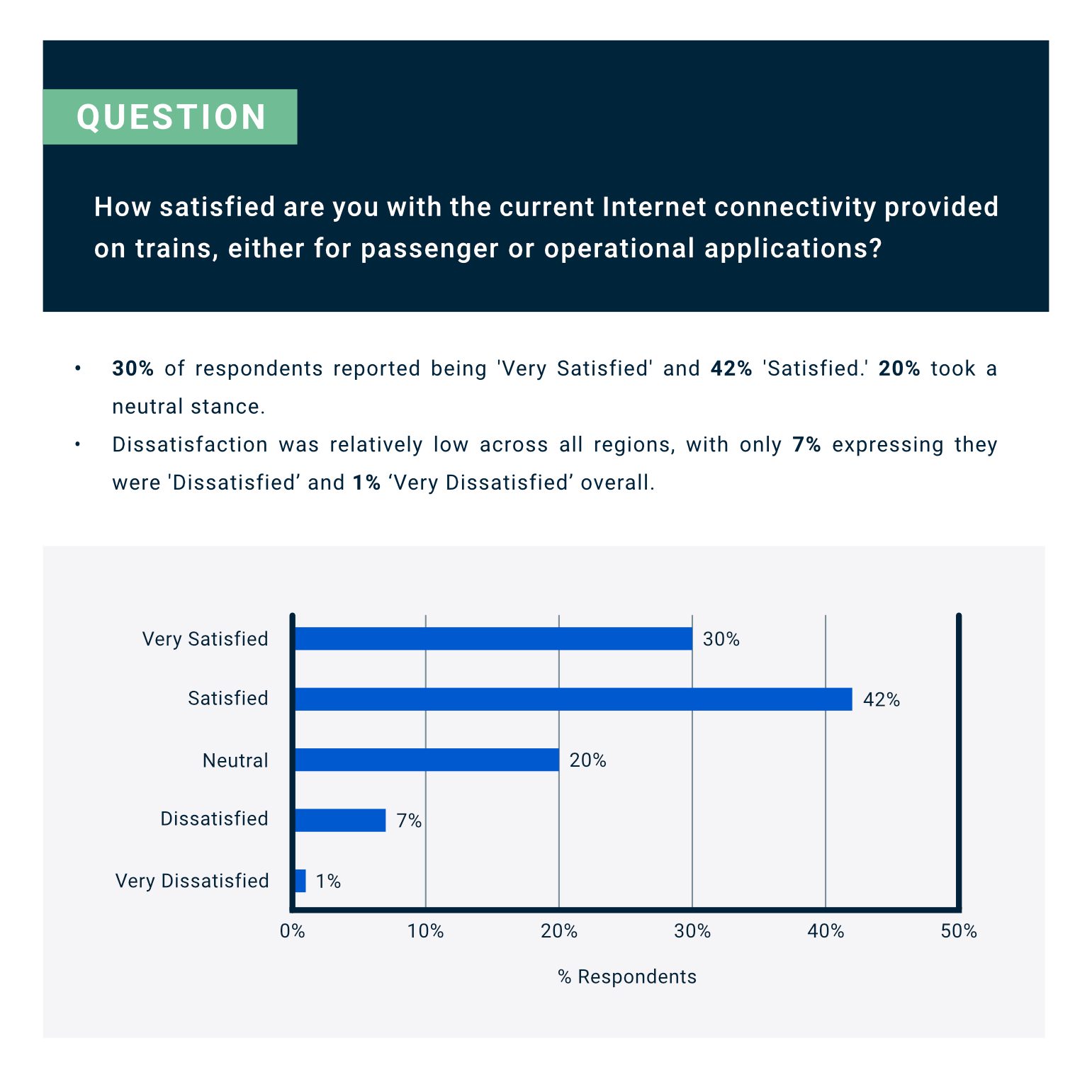
3. A Combination of Communications Technologies Will Significantly Enhance Internet Connectivity on Trains
The quality of an on-train Internet connection is highly dependent on the coverage and capacity of the communication networks along the route. When asked which emerging or established communication technologies could most significantly enhance Internet connectivity on trains, industry professionals placed cellular networks first (62% of respondents), followed by satellite constellations (56%) and then private trackside networks (29%). All regions included in the survey followed this order, with the exception of the United Kingdom, where the potential of commercial cellular networks and satellite Internet were both recognised by 63% of those surveyed.
Today on-train Internet connectivity is largely delivered through cellular networks. The general preference for utilising current cellular network technologies is due to their widespread deployment and continual evolution, for example, the 5G rollout, while the strong interest in satellite Internet, especially LEO satellites, suggests an awareness of their potential to offer high-speed connectivity, particularly along routes that traditional cellular networks may not cover effectively. The lower interest in private trackside networks still reflects recognition of their potential to offer enhanced data throughput in rural locations or in challenging environments such as tunnels, albeit with the understanding that such networks can be more costly and time-intensive for a rail operator or infrastructure owner to create and maintain.
By taking a hybrid approach and intelligently utilising a range of different connectivity technologies together in tandem, transport operators will be best placed to gain maximum value well into the future.
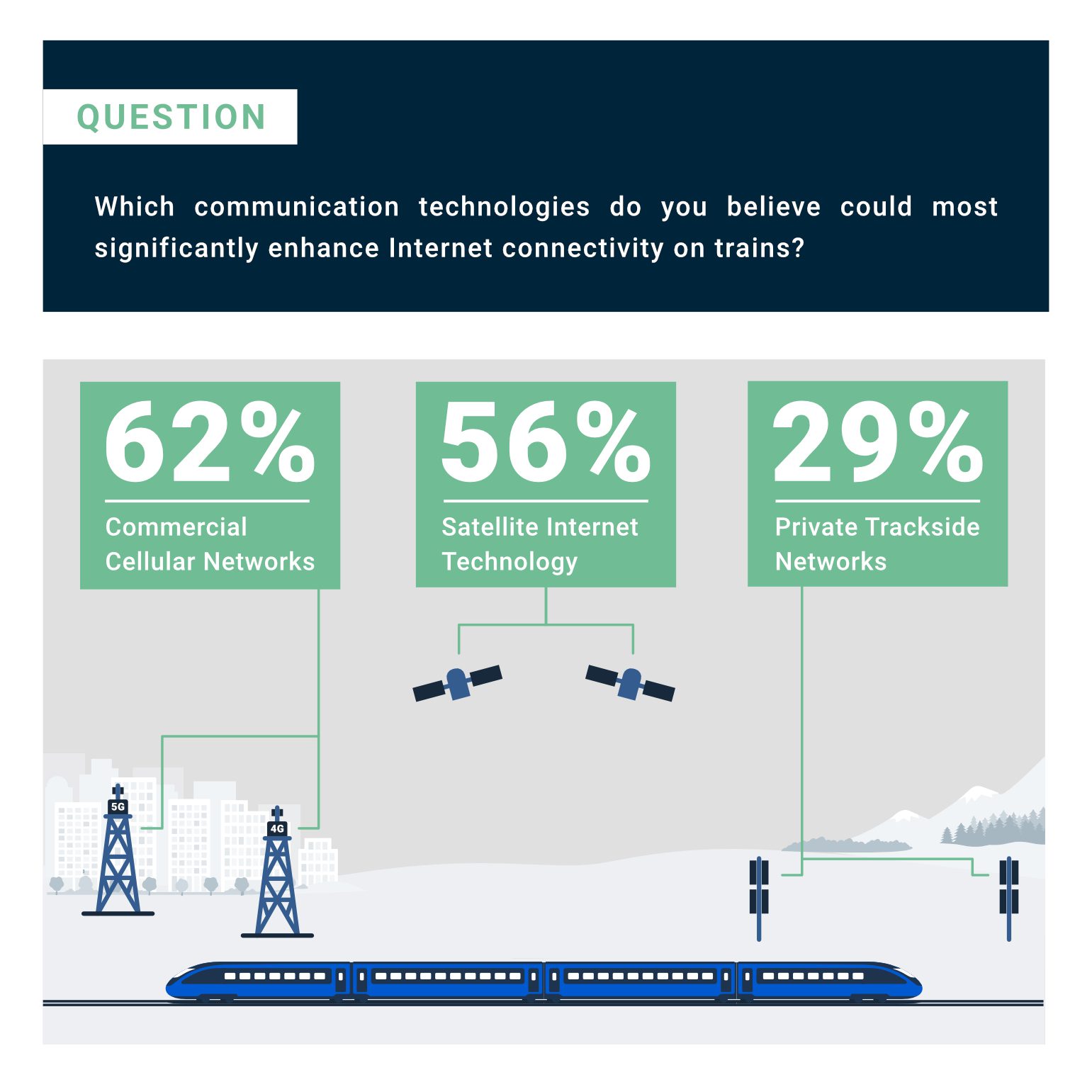
4. Rail Industry Professionals Believe That There Should Be More Investment in Improving Onboard Internet Connectivity
Given the importance of on-train Internet connectivity amongst rail professionals has been established across other answers in our survey, it should come as no surprise that a significant majority – 87% of respondents – support increased investment in this area.
Writing in the New Statesman, Daniel Susskind, an economist at Oxford University and King’s College London, conservatively estimated that an investment in passenger Wi-Fi would yield five times the economic value in return. And as we have already discussed, passenger Wi-Fi is just one application served by the connection to and from the moving vehicle – Susskind’s estimate does not consider the value of improving the safety and operational efficiency of a rail network, which would only strengthen the business case.
Over the coming years the transport industry will have to contend with multiple factors that will influence the way we travel, from post-pandemic behavioural changes, climate change and threats arising from global conflicts, to ageing populations and the blurring of boundaries between the physical and digital worlds.
In order to best serve society in the face of these developments, the transport industry needs to simultaneously pursue three objectives to attract passengers and meet the increase in demand that comes from shifting society’s travel habits further towards sustainable, green mobility:
1. Catering for the evolving needs of business and leisure commuters, regardless of age or disability
2. Offering a safe environment that guards against physical and cyber threats to individuals and to wider infrastructure
3. Achieving the above in a cost-effective and resilient way that also allows the industry to adapt to rapidly changing environmental, societal, and economic needs in the future.
Clearly, investments that can deliver against all three of these objectives should be prioritised, and onboard Internet connectivity is one such investment.
With an increasing number of onboard devices or systems requiring connectivity, the increasing value of the data they generate, and the increasing importance of its timely availability, ensuring the reliable and secure transmission of the data that all these systems generate and utilise, to and from the moving vehicle, is key.
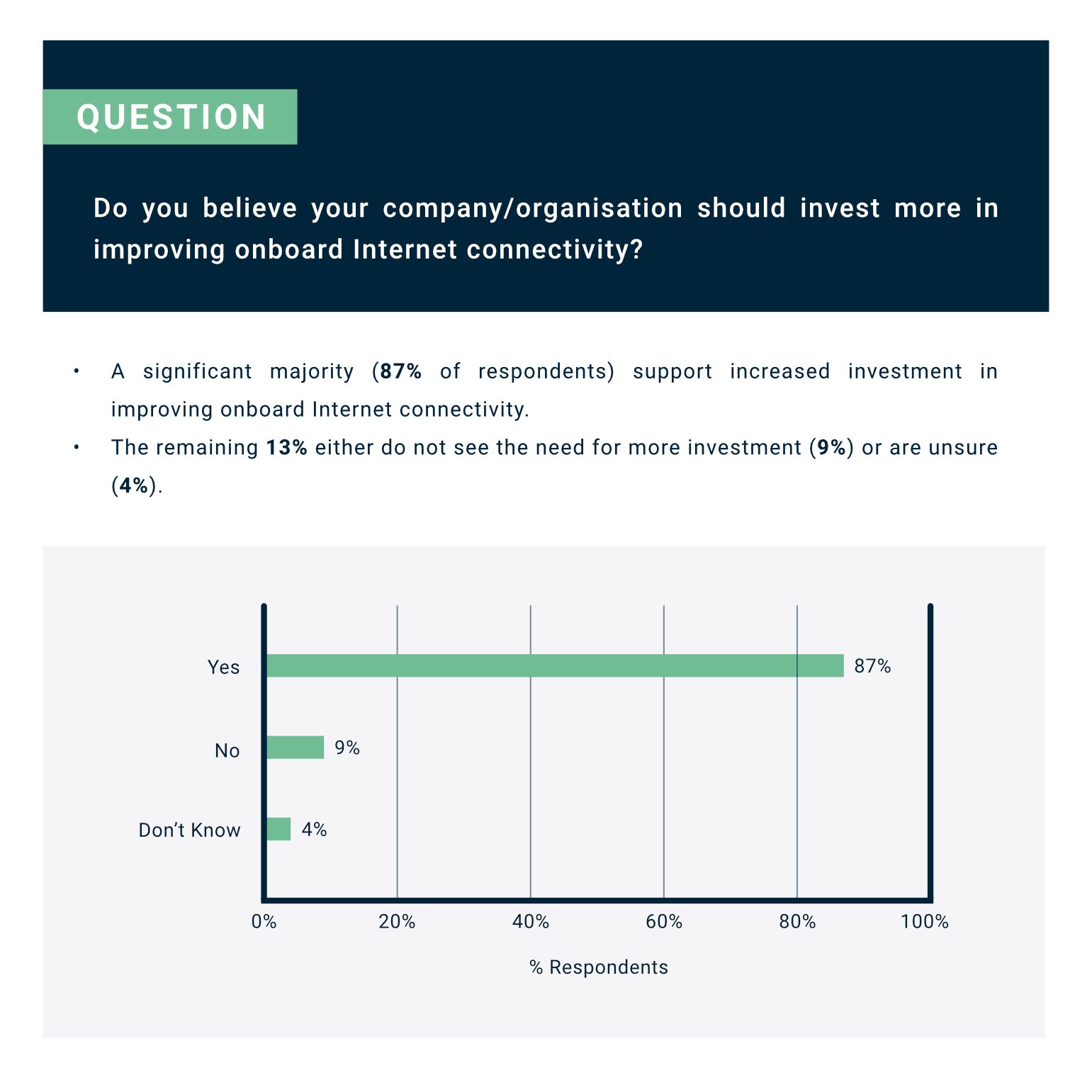
The Essential Role of On-Train Internet Connectivity
Our survey results paint a clear picture: On-train Internet connectivity is seen as a pivotal element for the evolution of the rail industry by the people who will be responsible for overseeing it. This sentiment reflects the increasing digitalisation of all aspects of transportation and the need for robust, consistent connectivity for both passenger and operational applications.
Looking ahead, the rail industry must navigate various challenges and opportunities. By prioritising investments in onboard Internet connectivity, the industry can meet these challenges head-on, ensuring sustainable growth and improved service for passengers and operators alike.
This article features in Icomera’s 48-page industry report “Connectivity Insights 2024”.
Read the full report below or via this link to find out more about the expanding role of connectivity in supporting the rail industry’s goals, and the adoption of new technologies and innovations…
